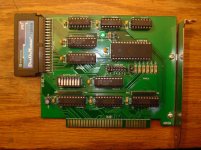bettablue
Veteran Member
OK, most of you know the battles I've had getting my IBM 5150 working properly. :crutch: So now that I have the issues all nailed down to what I originally thought the problem was, the floppy drives, one of which has finally been replaced; the computer is working great! :happy4:
I am now thinking about what expansion cards are available for the system and what they are typically used for. :computer:
My 5150 currently has the following hardware:
1. Original 83 key PC/XT keyboard
2. CGA video card and display
3. 2 - 360 K floppy drives - (still awaiting one to replace me secondary drive) There is no hard drive, and I don't want one installed. For me, that ruins the experiance of using this computer the way it was meant to be used.
4. 640 K RAM card
5. Parallel port card
As you can see, there aren't a lot of updates installed in this machine. :roadwork: I am curious now; what expansion cards are available for the system and what are they typically used for. What add-ons would you recommend, and finally, what additional functionality can I expect from them?
Here are some of the things I am interested in:
1. Connect the computer to my primary Windows 7 computer, either through the cassette port (similar to what is currently being done with Apple ll systems, although I don't know of a way to convert disk images to wav files for use with the Windows 7 computer's sound card, .) or through my network by way of my Belkin wired/wireless router. :arrow:
2. Communications, ( I was actually thinking about using an acoustic coupler, simply to expand on the geek facor.) There are still a few BBS's and services out there I can dial into. hone:
hone:
3. File sharing and storage - see #5 :danceparty:
4. Printing (I will probably be getting an original IBM branded "graphics" printer in the next few weeks) :yinyang:
5. Mass storage (Here, I have a 100 Meg zip drive, and thanks to modem7, a Laplink 3 parallel cable.) to access a very large collection of vintage DOS programs and games. :grab:
I know there are a lot of things I haven't though about. I would love to hear your ideas, comments, and recommendations.
I would love to hear your ideas, comments, and recommendations.
Thanks again everybody. :bow2:
I am now thinking about what expansion cards are available for the system and what they are typically used for. :computer:
My 5150 currently has the following hardware:
1. Original 83 key PC/XT keyboard
2. CGA video card and display
3. 2 - 360 K floppy drives - (still awaiting one to replace me secondary drive) There is no hard drive, and I don't want one installed. For me, that ruins the experiance of using this computer the way it was meant to be used.
4. 640 K RAM card
5. Parallel port card
As you can see, there aren't a lot of updates installed in this machine. :roadwork: I am curious now; what expansion cards are available for the system and what are they typically used for. What add-ons would you recommend, and finally, what additional functionality can I expect from them?
Here are some of the things I am interested in:
1. Connect the computer to my primary Windows 7 computer, either through the cassette port (similar to what is currently being done with Apple ll systems, although I don't know of a way to convert disk images to wav files for use with the Windows 7 computer's sound card, .) or through my network by way of my Belkin wired/wireless router. :arrow:
2. Communications, ( I was actually thinking about using an acoustic coupler, simply to expand on the geek facor.) There are still a few BBS's and services out there I can dial into.
3. File sharing and storage - see #5 :danceparty:
4. Printing (I will probably be getting an original IBM branded "graphics" printer in the next few weeks) :yinyang:
5. Mass storage (Here, I have a 100 Meg zip drive, and thanks to modem7, a Laplink 3 parallel cable.) to access a very large collection of vintage DOS programs and games. :grab:
I know there are a lot of things I haven't though about.
Thanks again everybody. :bow2:


